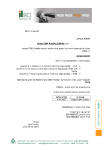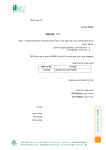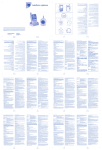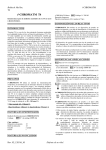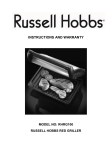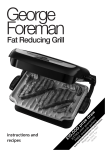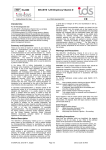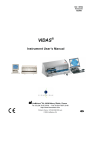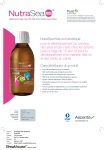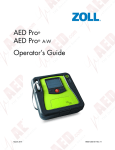Download VIDAS® 25 OH Vitamin D TOTAL
Transcript
42אוקטובר4102 ,
לקוחות נכבדים,
הנדון :בדיקת Vitamin Dעל מכשיר הVidas -
חברת אילקס שמחה להודיע על השקת ערכה חדשה לבדיקת Vitamin Dבמכשיר ה-
.Vidas
יתרונות הערכה:
הרצת קליברציה קונטרולות פעם ב 42 -יום.
טווח מדידה .8-126 ng/ml
זמן לקבלת תוצאה -כ 21 -דקות.
להלן המק"ט להזמנה:
שם פריט
VIDAS Vitamin D Total
מק"ט אילקס
5-21202
מצ"ב מידע מחברת BioM’erieux
למידע נוסף ניתן לפנות ל:
עילית ליזרמן152-0020022 ,
אורלי דויטש152-5020212 ,
בברכה,
עילית ליזרמן
אילקס מדיקל בע"מ.
30 463
9304004 B - en - 2013/08
VIDAS® 25 OH Vitamin D TOTAL (VITD)
VIDAS 25 OH Vitamin D TOTAL (VITD) is an automated quantitative test for use on the instruments of the VIDAS family
for the determination of 25-hydroxyvitamin D Total in human serum or plasma using the ELFA technique (Enzyme
Linked Fluorescent Assay).
The VIDAS 25 OH Vitamin D TOTAL assay is to be used as an aid in the assessment of Vitamin D sufficiency.
SUMMARY AND EXPLANATION
Vitamin D is a fat-soluble steroid prohormone. Vitamin D
deficiency can be associated with rickets in children, and
osteoporosis and secondary hyper-parathyroidism in
adults. Recent studies have established a link between
low circulating vitamin D levels and an increasing risk of
diabetes, cardiovascular or autoimmune diseases as well
as various forms of cancer (1-8). Vitamin D testing has
become an assay of general health status (9).
Vitamin D is found mainly in two forms: vitamin D2
(ergocalciferol) and vitamin D3 (cholecalciferol). Vitamin
D3 is synthesized from 7-dehydrocholesterol by action of
solar ultraviolet radiation on the skin. It is also present in
food (mostly in fatty fish). Vitamin D2 is from exogenous
origin only. Small amounts of vitamin D2 are present in
food (mushrooms, vegetables). Both vitamins D2 and D3
are used for medical supplementation and are identically
metabolized by the body.
The active form of the molecule is the 1,25-(OH)2 vitamin
D (calcitriol) which is obtained from vitamin D through two
successive hydroxylation reactions. The first hydroxylation
occurs in the liver to yield 25-(OH) vitamin D (calcidiol).
The second hydroxylation occurs in the kidneys and other
tissues as well to yield biologically active 1,25-(OH)2
vitamin D. The 25-(OH) vitamin D is the main storage form
of vitamin D in the human body. It is found in high
concentrations in serum or plasma, which makes 25-(OH)
vitamin D the preferred analyte for the determination of
vitamin D nutritional status (10).
PRINCIPLE
The assay principle combines an enzyme immunoassay
competition method with a final fluorescent detection
(ELFA).
®
The Solid Phase Receptacle (SPR ) serves as the solid
phase as well as the pipetting device for the assay.
Reagents for the assay are ready-to-use and predispensed in the sealed reagent strips.
All of the assay steps are performed automatically by the
instrument. The reaction medium is cycled in and out of
the SPR several times.
The sample is mixed with pre-treatment reagent to
separate vitamin D from its binding protein.
The pre-treated sample is then collected and transferred
into the well that contains an alkaline phosphatase (ALP)labeled anti-vitamin D antibody (conjugate).
The vitamin D antigen present in the sample and the
vitamin D antigen coating the interior of the SPR compete
for binding sites on the anti-vitamin D antibody-ALP
conjugate.
During the final detection step, the substrate (4-Methylumbelliferyl phosphate) is cycled in and out of the SPR.
The conjugate enzyme catalyzes the hydrolysis of this
substrate into a fluorescent product (4-Methylumbelliferone), the fluorescence of which is measured at
450 nm. The intensity of the fluorescence is inversely
proportional to the concentration of vitamin D antigen
present in the sample. At the end of the assay, results are
automatically calculated by the instrument in relation to
the calibration curve stored in memory, and then printed
out.
KIT COMPOSITION (60 TESTS):
60 VITD Strips
STR
Ready-to-use. Stabilizer of human origin*.
60 VITD SPRs
2 x 30
SPR
Ready-to-use.
Interior of SPR coated with vitamin D.
Control VITD
1 x 1.5 mL (liquid)
C1
Ready-to-use.
25-(OH) Vitamin D diluted in human serum* + preservative.
The confidence interval in ng/mL is indicated on the MLE card after the following
mention: "Control C1 Dose Value Range".
Calibrator VITD
1 x 2.5 mL (liquid)
S1
Ready-to-use.
25-(OH) Vitamin D diluted in human serum* + preservative.
The concentration in ng/mL is indicated on the MLE card after the following mention:
"Calibrator (S1) Dose Value". The confidence interval in "Relative Fluorescence
Value (RFV)" is indicated on the MLE card after the following mention: "Calibrator
(S1) RFV Range".
1 MLE Card (Master Lot Entry)
Specifications for the factory master data required to calibrate the test: to read the
MLE data, please refer to the User’s Manual.
1 Package insert provided in the kit or downloadable from www.biomerieux.com/techlib.
* This product has been tested and shown to be negative for HBs antigen and antibodies to HIV1, HIV2 and HCV. However, since no
existing test method can totally guarantee their absence, this product must be treated as potentially infectious. Therefore, usual safety
procedures should be observed when handling.
bioMérieux SA
English - 1
VIDAS® 25 OH VITAMIN D TOTAL (VITD)
9304004 B - en - 2013/08
The SPR
The interior of the SPR® is coated during production
with vitamin D. Each SPR is identified by the "VITD"
code. Only remove the required number of SPRs from
the pouch and carefully reseal the pouch after
opening.
The Reagent Strip
The strip consists of 10 wells covered with a labeled,
foil seal. The label comprises a bar code which mainly
indicates the assay code, kit lot number and expiration
date. The foil of the first well is perforated to facilitate
the introduction of the sample. The last well of each
strip is a cuvette in which the fluorometric reading is
performed. The wells in the center section of the strip
contain the various reagents required for the assay.
Description of the VITD strips:
Wells
Reagents
1
Sample Well.
2
Conjugate: TRIS, NaCl + anti-vitamin D antibody conjugated with alkaline
phosphatase + stabilizer of human origin* + preservative (300 µL).
3
Pre-treatment solution: TRIS, NaCl + dissociation agent + surfactant + methanol**
(600 µL).
4-5-6
Empty well
7-8-9
Wash buffer: TRIS, NaCl + preservative + surfactant (600 µL).
10
Reading cuvette with substrate: 4-Methyl-umbelliferyl phosphate (0.6 mmol/l) +
diethanolamine*** (DEA) (0.62 mol/L or 6.6%, pH 9.2) + 1 g/L sodium azide
(300 µL).
* This product has been tested and shown to be negative for HBs antigen and antibodies to HIV1, HIV2 and HCV. However, since no
existing test method can totally guarantee their absence, this product must be treated as potentially infectious. Therefore, usual safety
procedures should be observed when handling.
**HARMFUL reagent:
− R20/21/22 : Harmful by inhalation, in contact with skin and if swallowed.
− R68/20/21/22 : Harmful: possible risk of irreversible effects through inhalation and in contact with skin.
− S36/37/39 : Wear suitable protective clothing, gloves and eye/face protection.
*** IRRITANT reagent:
- R 36: Irritating to eyes.
- S 26: In case of contact with eyes, rinse immediately with plenty of water and seek medical advice.
For further information, refer to the Safety Data Sheet available on request.
MATERIALS AND DISPOSABLES REQUIRED BUT
NOT PROVIDED
− Pipette with disposable tip to dispense 100 µL.
− Powderless, disposable gloves.
− For other specific materials and disposables, please
refer to the Instrument User’s Manual.
− Instrument of the VIDAS family.
WARNINGS AND PRECAUTIONS
• For in vitro diagnostic use only.
• For professional use only.
• This kit contains products of human origin. No
known analysis method can totally guarantee the
absence of transmissible pathogenic agents. It is
therefore recommended that these products be
treated as potentially infectious and handled
observing the usual safety precautions (see
Laboratory biosafety manual - WHO - Geneva latest edition).
• This kit contains products of animal origin. Certified
knowledge of the origin and/or sanitary state of the
animals does not totally guarantee the absence of
transmissible pathogenic agents. It is therefore
recommended that these products be treated as
potentially infectious and handled observing the usual
safety precautions (do not ingest or inhale).
• Do not use the SPRs if the pouch is pierced or if the
dot sealing a SPR is detached.
bioMérieux SA
• Do not use visibly deteriorated STRs (damaged foil or
plastic).
• Do not use reagents after the expiration date
indicated on the label.
• Do not mix reagents (or disposables) from different
lots.
• Use powderless gloves, as powder has been
reported to cause false results for certain enzyme
immunoassay tests.
• Kit reagents contain sodium azide which can react
with lead or copper plumbing to form explosive metal
azides. If any liquid containing sodium azide is
disposed of in the plumbing system, drains should be
flushed with water to avoid build-up.
• The reading cuvette with pre-treatment solution
(well 3) contains a harmful reagent (methanol =
CH3OH). Refer to the risk phrase “R” and the
precautions “S” above.
• The reading cuvette with substrate (well 10) contains
an irritant agent (6.6% diethanolamine). Refer to the
risk phrase “R” and the precautions “S” above.
• Spills should be wiped up thoroughly after treatment
with liquid detergent or a solution of household bleach
containing at least 0.5% sodium hypochlorite. See the
User’s Manual for cleaning spills on or in the
instrument. Do not autoclave solutions containing
bleach.
• The instrument should be regularly cleaned and
decontaminated (see the User’s Manual).
English - 2
VIDAS® 25 OH VITAMIN D TOTAL (VITD)
9304004 B - en - 2013/08
STORAGE CONDITIONS
• Store the VIDAS 25 OH Vitamin D TOTAL kit at
2-8°C.
• Do not freeze reagents.
• Store all unused reagents at 2-8°C.
®
• After opening the kit, check that the SPR pouch is
correctly sealed and undamaged. If not, do not use
the SPRs.
• Carefully reseal the pouch with the desiccant
inside after use to maintain stability of the SPRs
and return the complete kit to 2-8°C.
• If stored according to the recommended conditions,
all components are stable until the expiration date
indicated on the label.
SPECIMENS
Specimen type and collection:
Human serum or plasma (lithium heparin).
Do not use EDTA tubes.
Types of tubes validated:
− Plastic tube with clot activator,
− Plastic tube with separation gel and clot activator,
− Plastic tube with lithium heparin,
− Plastic tube with lithium heparin and separation gel.
Note: Blood collection tube results may vary from one
manufacturer to another depending on the materials
and additives used.
It is the responsibility of each laboratory to validate the
type of sample tube used and to follow the
manufacturer’s recommendations for use.
Samples containing suspended fibrin particles or
erythrocyte stroma should be centrifuged before testing.
Specimen preparation
Plain tubes: wait for samples to coagulate and
centrifuge according to the tube manufacturer’s
recommendations to eliminate fibrin.
Other tubes: follow the tube manufacturer’s
recommendations for use.
Frozen-stored samples: after thawing, these samples
must be homogenized before testing. Mix using a
vortex-type mixer. Clarify the samples before analysis
by centrifugation, if necessary.
The pre-analytical step including the preparation of
blood samples is an essential first step when
performing medical analyses. In conformity with Good
Laboratory Practices, this step is the responsibility of
the laboratory manager.
Insufficient clot time can result in the formation of fibrin
with micro-clots that are invisible to the naked eye. The
presence of fibrin, red blood cells, or suspended
particles can lead to erroneous results.
Samples containing suspended fibrin particles or
erythrocyte stroma should be centrifuged before testing.
For serum specimens, ensure that complete clot
formation has taken place prior to centrifugation. Some
specimens, especially those from patients receiving
anticoagulant or thrombolytic therapy, may exhibit
increased clotting times.
bioMérieux SA
Specimen-related interferences
Interferences have been studied according to the
recommendations of Clinical and Laboratory Standards
®
Institute (CLSI ) document EP7-A2 (11).
None of the following factors have been found to
significantly influence this assay:
- hemolysis (after spiking samples with hemoglobin:
0 to 1.9 g/L (monomer)),
- lipemia (after spiking samples with lipids: 0 to 4.0 g/L
equivalent in triglycerides),
- bilirubinemia (after spiking samples with bilirubin: 0 to
0.3 g/L),
- cholesterol (after spiking samples with cholesterol: 0
to 5 g/L).
However, it is recommended not to use samples that
are clearly hemolyzed, lipemic or icteric and, if possible,
to collect a new sample.
Specimen stability
Serum and plasma samples can be stored in primary
tube at 18-25°C for up to 8 hours or aliquoted at 2-8°C
for up to 5 days; if longer storage is required, freeze the
sera or plasma at–25 ± 6°C. Serum-type samples can
be stored for 3 months at -25 ± 6°C, with
3 freeze/thaw cycles. Plasma-type samples can be
stored for 3 months at -25 ± 6°C, with 3 freeze/thaw
cycles.
INSTRUCTIONS FOR USE
For complete instructions, see the Instrument
User’s Manual.
VIDAS PTC protocol data entry
When using the assay for the first time, and before
reading the MLE data, scan the bar code(s) (at the
end of the package insert or downloadable from
www.biomerieux.com/techlib) using the instrument’s
external bar code reader.
This reading will allow VIDAS PTC protocol data to be
transferred to the instrument software for its update.
These data should only be read the first time the assay
is used.
Master lot data entry
Note: When using the assay for the first time, enter
®
the VIDAS PTC protocol (bar codes at the end of
the package insert or downloadable from
www.biomerieux.com/techlib) before reading the
MLE data. If the MLE data have been read before the
VIDAS PTC protocol, read the MLE data again.
Before each new lot of reagents is used, specifications
(or factory master calibration curve data) must be
entered into the instrument using the MLE data. If this
operation is not performed before initiating the tests,
the instrument will not be able to print results. The
master lot data need only be entered once for each lot.
It is possible to enter the MLE data manually or
automatically depending on the instrument (refer to the
User’s Manual).
Calibration
Calibration, using the calibrator provided in the kit, must
be performed each time a new lot of reagents is
opened, after the master lot data have been entered.
Calibration should then be performed every 28 days.
This operation provides instrument-specific calibration
curves and compensates for possible minor variations
in assay signal throughout the shelf-life of the kit.
English - 3
VIDAS® 25 OH VITAMIN D TOTAL (VITD)
9304004 B - en - 2013/08
The calibrator, identified by S1, must be tested in
duplicate (see User’s Manual). The calibrator value
must be within the set RFV ("Relative Fluorescence
Value"). If this is not the case, recalibrate using S1.
Procedure
1. Only remove the required reagents from the
refrigerator. They can be used immediately.
®
2. Use one "VITD" strip and one "VITD" SPR from the
kit for each sample, control or calibrator to be
tested. Make sure the storage pouch has been
carefully resealed after the required SPRs have
been removed.
3. The test is identified by the "VITD" code on the
instrument. The calibrator must be identified by
"S1", and tested in duplicate. If the control is to be
tested, it should be identified by "C1".
4. If necessary, clarify the samples by centrifugation.
5. Mix the calibrator, control and samples using a
vortex-type mixer (for serum or plasma separated
from the pellet).
6. Before pipetting ensure that samples, calibrators,
controls and diluent are free of bubbles.
7. For this test, the calibrator, control, and sample
test portion is 100 µL.
8. Insert the "VITD" SPRs and "VITD" strips into the
instrument. Check to make sure the color labels with
the assay code on the SPRs and the Reagent Strips
match.
9. Initiate the assay as directed in the User's Manual.
All the assay steps are performed automatically by
the instrument.
10. Reclose the vials and return them to 2–8°C after
pipetting.
11. The assay will be completed within approximately
40 minutes. After the assay is completed, remove
the SPRs and strips from the instrument.
12. Dispose of the used SPRs and strips into an
appropriate recipient.
RESULTS AND INTERPRETATION
Once the assay is completed, results are analyzed
automatically by the computer. Fluorescence is
measured twice in the Reagent Strip’s reading cuvette
for each sample tested.
The first reading is a background reading of the
substrate cuvette before the SPR is introduced into the
substrate. The second reading is taken after incubating
the substrate with the enzyme remaining on the interior
of the SPR. The RFV (Relative Fluorescence Value) is
calculated by subtracting the background reading from
the final result. This calculation appears on the result
sheet.
The results are automatically calculated using
calibration curves which are stored by the instrument
(4-parameter logistics model) and are expressed in
ng/mL or nmol/L.
Assay results should be used in conjunction with other
clinical or laboratory data to assist the clinician in
making individual patient management decisions.
bioMérieux SA
QUALITY CONTROL
One control is included in each VIDAS 25 OH Vitamin D
TOTAL kit.
This control must be performed immediately after
opening a new kit to ensure that reagent performance
has not been altered. Each calibration must also be
checked using this control. The instrument will only be
able to check the control value if it is identified by C1.
Results cannot be validated if the control value deviates
from the expected value.
Note
It is the responsibility of the user to perform Quality
Control in accordance with any local applicable
regulations.
LIMITATIONS OF THE METHOD
• Interference may be encountered with certain sera
containing antibodies directed against reagent
components. For this reason, assay results should be
interpreted taking into consideration the patient's
history, and the results of any other tests performed.
RANGE OF EXPECTED VALUES
It is recommended that each laboratory establish its
own reference range, which may be unique to the
population it serves. A review of the most recent
literature suggests the recommendation for 25-OH
Vitamin D levels are (12):
Status
25-(OH) vitamin D
Deficient
< 20 ng/ml
Insufficient
20-29 ng/ml
Sufficient
30-100 ng/ml
Potential toxicity
> 100 ng/ml
A reference range study was conducted using 140
apparently healthy adults, based on guidance from
CLSI C28-A3. Serum samples were collected in from a
French population between January and December,
and were tested using VIDAS 25 OH Vitamin D TOTAL
assay. The values observed are summarized below*:
Observed values
(n=140)
25-(OH) vitamin D (ng/ml)
Median
23.1
Observed range
(2.5th to 97.5th
percentile)
9.3 – 48.5
(*) Indicative results: the results obtained can vary from
one laboratory to another and according to the
geographical zones.
English - 4
VIDAS® 25 OH VITAMIN D TOTAL (VITD)
9304004 B - en - 2013/08
PERFORMANCE
Studies performed using VIDAS® 25 OH Vitamin D TOTAL kit gave the following results:
Measurement range
The VIDAS 25 OH Vitamin D TOTAL measurement range extends from 8.1 ng/mL up to 126.0 ng/mL. Values below the
lower limit of the measurement range are reported as < 8.1 ng/mL. Values above the upper limit of the measurement
range are reported as > 126.0 ng/mL.
Detection and quantitation limits
The Limit of Blank is the 95th percentile of more than 60 measurements of analyte free samples. LoB corresponds to the
concentration below which the probability to obtain analyte-free samples is 95%. LoB was determined to be 6.2 ng/mL.
The Limit of Detection (LoD) is the concentration of 25(OH) Vitamin D in a sample that can be distinguished from the
analyte free sample with a probability of 95%. The LoD was determined to be 8.1 ng/mL.
The Limit of Quantitation (LoQ) is the lowest concentration of 25(OH) Vitamin D that can be quantified with a level of
acceptable accuracy and precision. The LoQ was determined to be 8.1 ng/mL.
The study was performed as recommended by CLSI® document EP17-A2.
Functional detection limit
The functional detection limit is defined as the concentration of 25(OH) Vitamin D measured with an inter-assay
coefficient of variation of 20%. During an in-house study, the functional detection limit was determined to be < 8.1 ng/mL.
Linearity
The VIDAS 25 OH Vitamin D TOTAL assay is linear over its measurement range (7.1 à 126.2 ng/mL), evaluated
®
according to the recommendations of CLSI document EP6-A.
Precision
®
A study was performed according to the recommendations of CLSI document EP5-A2. A panel of 5 human samples
covering the measurement range was tested as follows: each sample was tested in duplicate in 2 separate runs per day
over 20 days, using two reagent lots (10 test days per reagent lot) on 3 instruments (N=240 values per sample). The
3 instruments were located at one site. Two calibrations were used for each reagent lot (5 test days per calibration for
each lot). The repeatability (within-run precision) and reproducibility (within-instrument between-lot) were calculated for
each sample using this protocol and are reported in the following table:
Sample
N
Mean
concentration
(ng/mL)
Repeatability
(Within-instrument
between-lot) reproducibility
Standard
deviation
(ng/mL)
CV (%)
Standard
deviation
(ng/mL)
CV (%)
Sample 1
240
17.1
1.1
6.4
1.8
10.5
Sample 2
240
21.6
1.1
5.2
1.7
8.1
Sample 3
240
30.5
1.3
4.2
1.7
5.6
Sample 4
240
46.7
1.4
3.0
2.3
4.9
Sample 5
240
100.0
2.4
2.4
3.3
3.3
bioMérieux SA
English - 5
VIDAS® 25 OH VITAMIN D TOTAL (VITD)
9304004 B - en - 2013/08
Specificity
The specificity of the VIDAS 25 OH Vitamin D TOTAL assay was assessed by testing cross-reactants according to the
®
recommendations of the CLSI document EP7-A2. Cross-reactivity was evaluated by adding the following substances to
samples containing 25(OH) Vitamin D. The results of this study are summarized in the following table:
a
Tested compound
Concentration
% Cross reactivity
Vitamin D2
100 ng/mL
9
Vitamin D3
100 ng/mL
6
1,25(OH)2 Vitamin D2 *
100 ng/mL
6
1,25(OH)2 Vitamin D3 *
100 ng/mL
81
24,25(OH)2 Vitamin D3 *
10 ng/mL
588
3 epi 25(OH) Vitamin D3
100 ng/mL
5
* levels tested were 10x to 1000x the typical endogenous levels of analyte
a
Cross reactivity (%) =
Mean Value spiked (ng/ml) - Mean Value unspiked (ng/ml)
concentrat ion of cross - reactant (ng/ml)
× 100
b
The cross-reactivity to 25(OH) Vitamin D2 was determined using natural sera that contain endogenous 25(OH) Vitamin
D, without spiking. Samples were analyzed by liquid chromatography coupled to mass spectrometry method (LC-MS/MS)
in order to determine 25(OH) Vitamin D2 and 25(OH) Vitamin D3 respective concentrations. Samples that were included
in this study showed a ratio [25(OH) Vitamin D2]/[ 25(OH) Vitamin D3] >4.
b
25(OH) Vitamin D2 cross reactivity (%) =
25(OH)D (Vidas) - 25(OH)D3 (LC - MS/MS)
25(OH)D2 (LC - MS/MS)
× 100
The mean 25(OH) Vitamin D2 cross reactivity for VIDAS 25 OH Vitamin D TOTAL assay is 91%.
Interference
The VIDAS 25 OH Vitamin D TOTAL was evaluated for interference consistent with CLSI document EP7 A2.
None of the following factors have been found to significantly influence this assay:
Human Albumin
0 to 60 g/L
Rheumatoid factors
0 à 577.7 IU/mL
HAMA
0 à 2 µg/mL
bioMérieux SA
English - 6
VIDAS® 25 OH VITAMIN D TOTAL (VITD)
9304004 B - en - 2013/08
Method comparison
1) A comparison of the VIDAS 25 OH Vitamin D TOTAL assay (Y) with the IDS-iSYS 25-Hydroxy Vitamin D assay (X)
assay gave the following results:
Number of samples analyzed: 344
Equation for Passing-Bablok regression:
Coefficient of correlation: 0.93
Y = 0.87 X – 0.81
The sample concentrations analyzed with VIDAS 25 OH Vitamin D TOTAL ranged between 8.2 ng/mL and 98.2 ng/mL.
2) A comparison of the VIDAS 25 OH Vitamin D TOTAL assay (Y) with a LC-MS/MS method (X) assay gave the following
results:
Number of samples analyzed: 343
Equation for Passing-Bablok regression:
Coefficient of correlation: 0.86
Y = 1.00 X + 0.41
The sample concentrations analyzed with VIDAS 25 OH Vitamin D TOTAL ranged between 8.2 ng/mL and 98.2 ng/mL.
bioMérieux SA
English - 7
VIDAS® 25 OH VITAMIN D TOTAL (VITD)
9304004 B - en - 2013/08
WASTE DISPOSAL
Dispose of used or unused reagents as well as any
other contaminated disposable materials following
procedures for infectious or potentially infectious
products.
It is the responsibility of each laboratory to handle
waste and effluents produced according to their nature
and degree of hazardousness and to treat and dispose
of them (or have them treated and disposed of) in
accordance with any applicable regulations.
INDEX OF SYMBOLS
Meaning
Symbol
Catalog number
In Vitro Diagnostic Medical Device
Manufacturer
Temperature limit
LITERATURE REFERENCES
1. HOLICK, M.F. (2007). Vitamin D deficiency. N Engl J Med,
357:266-281.
Use by
2. DOBNIG H, et al. Independent association of low serum
25-hydroxyvitamin D and 1,25-dihydroxyvitamin D levels
with all-cause and cardiovascular mortality. Arch Intern
Med. 2008 Jun 23;168(12):1340-9.
Batch code
Consult Instructions for Use
3. FREEDMAN BI, et al. Vitamin D, adiposity, and calcified
atherosclerotic plaque in african-americans. J Clin
Endocrinol Metab. 2010 Mar;95(3):1076-83.
4. REIS JP, VON MÜHLEN D, MILLER ER 3rd, MICHOS ED,
APPEL LJ. Vitamin D status and cardiometabolic risk
factors in the United States adolescent population.
Pediatrics. 2009 Sep;124(3):e371-9.
5. ZIPITIS CS, AKOBENG AK, 5- Vitamin D supplementation
in early childhood and risk of type 1 diabetes: a systematic
review and meta-analysis. Arch Dis Child. 2008
Jun;93(6):512-7.
6. PITTAS AG, et al; 6-Vitamin D and calcium intake in
relation to type 2 diabetes in women., Diabetes Care. 2006
Mar;29(3):650-6.
7. YIN L, et al. Meta-analysis: longitudinal studies of serum
vitamin D and colorectal cancer risk. Aliment Pharmacol
Ther. 2009 Jul 1;30(2):113-25.
Contains sufficient for <n> tests
WARRANTY
bioMérieux disclaims all warranties, express or implied,
including
any
implied
warranties
of
MERCHANTABILITY
AND
FITNESS
FOR
A
PARTICULAR USE. BioMérieux shall not be liable for
any incidental or consequential damages. IN NO
EVENT SHALL BIOMERIEUX’S LIABILITY TO
CUSTOMER UNDER ANY CLAIM EXCEED A
REFUND OF THE AMOUNT PAID TO BIOMERIEUX
FOR THE PRODUCT OR SERVICE WHICH IS THE
SUBJECT OF THE CLAIM.
8. CHEN P, et al. Meta-analysis of vitamin D, calcium and the
prevention of breast cancer.
9. GRANT WB, HOLICK MF. Benefits and requirements of
vitamin D for optimal health: a review. Altern Med Rev.
2005 Jun;10(2):94-111.
10. HOLICK MF. Vitamin D status: measurement,
interpretation, and clinical application. Ann Epidemiol.
2009 Feb;19(2):73-8.
11. Clinical and Laboratory Standards Institute. Interference
Testing in Clinical Chemistry; Approved Guideline—
Second Edition. CLSI document EP7-A2: CLSI, 2005.
12. HOLICK MF et al.: Evaluation, Treatment, and Prevention
of Vitamin D Deficiency: an Endocrine Society Clinical
Practice Guideline; J Clin Endocrin Metab. July 2011,
96(7).
BIOMERIEUX, the blue logo, SPR and VIDAS are used, pending and/or registered trademarks belonging to bioMérieux, or one of its
subsidiaries, or one of its companies.
CLSI is a trademark belonging to Clinical Laboratory and Standards Institute, Inc.
Any other name or trademark is the property of its respective owner.
bioMérieux SA
Chemin de l'Orme
69280 Marcy-l'Etoile - France
RCS LYON 673 620 399
Tel. 33 (0)4 78 87 20 00
Fax 33 (0)4 78 87 20 90
www.biomerieux.com











